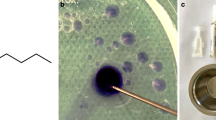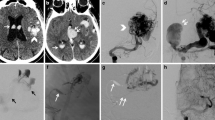Summary
Embolization of three surgically difficult cerebral aneurysms was performed using our newly developed non-adhesive embolic material, EVAL mixture (ethylene vinyl alcohol copolymer). Conventional embolic materials such as detachable balloons or microcoils were not used because of a large or irregular aneurysmal neck. After temporary occlusion of the parent artery with a superselective balloon catheter, the EVAL mixture was slowly injected through a microcatheter placed in the aneurysm or parent artery. The locations of the aneurysms were anterior communicating artery, basilar artery-posterior cerebral artery and basilar artery-anterior inferior cerebellar artery (BA-AICA). One aneurysmal occlusion and 2 parent artery occlusions were performed. Patients had no persistent deficits. The patient with the BA-AICA aneurysm associated with an arteriovenous malformation died of rupture of the residual AVM due to haemodynamic change 2 weeks after embolization. In selected and limited cases, embolization of surgically difficult cerebral aneurysms using EVAL mixture was more effective and safer than embolization using conventional embolic materials such as balloons and microcoils.
Similar content being viewed by others
References
Alksne JF, Smith RW (1977) Iron-acrylic compound for stereotaxic aneurysm thrombosis. J Neurosurg 47: 137–141
Brooks B (1930) The treatment of traumatic arteriovenous fistula. J South Med 23: 100–106
Casasco AE, Aymard A, Merland Jet al (1993) Selective endovascular treatment of 71 intracranial aneurysms with platinum coils. J Neurosurg 79: 3–10
Debrun G, Fox A, Drake C,et al (1981) Giant unclippable aneurysms: treatment with detachable balloons. AJNR 2: 167–173
Fox AJ, Vinuela F, Pelz DM,et al (1987) Use of detachable balloons for proximal artery occlusion in the treatment of unclippable cerebral aneurysms. J Neurosurg 66: 40–46
Guglielmi G, Vinuela F, Berenstein A,et al (1992) Endovascular treatment of posterior circulation aneurysm by electro-thrombosis using electrically detachable colis. J Neurosurg 77: 515–524
Higashida RT, Halbach VV, Hieshima GBet al (1989) Endovascular detachable balloon embolization therapy of cavernous carotid artery aneurysms: results in 87 patients. J Neurosurg 72: 857–863
Higashida RT, Halbach VV, Hieshima GBet al (1990) Treatment of intracranial aneurysms with preservation of the parent vessels: result of percutaneous balloon embolization in 94 patients. AJNR 11: 633–640
Kinugasa K, Ohmoto T, Nishoto A,et al (1992) Direct thrombosis of aneurysms with cellulose acetate polymer, Part 2. Preliminary clinical experience. J Neurosurg 77: 501–507
Kwan ESK, Heilman CB, Klucznik RPet al (1991) Enlargement of basilar artery aneurysms following balloon occlusion “water hammer effect”. Report of two cases. J Neurosurg 75: 963–968
Maks MP, Lane B, Steinberg GK,et al (1992) Intranidal aneurysms in cerebral arteriovenous malformations; evaluation and endovascular treatment. Radiology 183: 355–360
Nakahara I, Taki W, Kikuchi H,et al (1990) Treatment of giant anterior communicating artery aneurysm via an endovascular approach using detachable balloons and occlusive coils. AJNR 11: 1195–1197
Nishomoto A, Kuyama H, Nagao S,et al (1987) Artificial embolization with isobutyl-2-cyanoacrylate for the treatment of carotid-ophthalmic aneurysm. Surg Neurol 28: 46–50
Peerless SJ, Drake CG (1985) Posterior circulation aneurysms. In: Williams RH, Rengachary SS (eds) Neurosurgery. McGraw-Hill, New York, pp 1422–1437
Serbinenko FA (1974) Balloons catherization and occlusion of major cerebral vessels. J Neurosurg 41: 125–145
Sheptak PE, Zanetti PH, Susen AF (1977) The treatment of intracranial aneurysms by injection with a tissue adhesive. Neurosurgery 1: 25–29
Smith RH, Alksne JF (1977) Stereotaxic thrombosis of inaccessible intracranial aneurysms. J Neurosurg 47: 833–839
Taki W, Yonekawa Y, Iwata H,et al (1990) A new liquid material for embolization of arteriovenous malformation. AJNR 11: 163–168
Taki W, Handa H, Yamagata S,et al (1979) Balloons embolization of a giant aneurysm using a newly developed catheter. J Neurosurg 12: 363–365
Wada J, Rasumussen T (1969) Intracarotid injection of sodium amytal for the lateralization of cerebral speech dominance. J Neurosurg 17: 266–282
Author information
Authors and Affiliations
Rights and permissions
About this article
Cite this article
Nishi, S., Taki, W., Nakahara, I. et al. Embolization of cerebral aneurysms with a liquid embolus, EVAL mixture: Report of three cases. Acta neurochir 138, 294–300 (1996). https://doi.org/10.1007/BF01411740
Issue Date:
DOI: https://doi.org/10.1007/BF01411740




